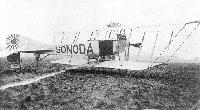
Описание
Страна: Великобритания
Год: 1912
R.Mikesh, A.Shorzoe Japanese Aircraft, 1910-1941 (Putnam)
Sonoda
Takehiko Sonoda was one of the early civilian aviators who were typical in coming from distinguished and affluent Japanese families. He was born in London when his father, Kokichi Sonoda, was with the Japanese consulate in England. After he returned to Japan where he finished his secondary school education, he went back to Britain and later graduated from the Glasgow Polytechnic in mechanical engineering. He accepted several jobs in various factories and a shipyard, all the while developing an interest in aviation. Eventually he was employed by the Handley Page Aircraft Co.
Sonoda Aeroplane
The British pioneer Frederick Handley Page was always interested in new design ideas for his aeroplanes. As an employee in the summer of 1912, Takehiko Sonoda influenced Handley Page's aeroplanes with a significantly improved approach in aircraft design.
Sonoda had designed an advanced two-seat biplane and wanted Handley Page to build it. Apart from providing useful paid work for Handley Page, Sonoda's design was of great interest because he had incorporated ailerons in the upper wing in place of the Handley Page practice of using wing warping for lateral control. Handley Page was so impressed by their advantages that after exhibiting his own Yellow Peril monoplane at the 1913 Olympia show, he fitted it with wide-chord ailerons which gave it much improved handling qualities.
The Sonoda Aeroplane was a wood and fabric two-bay unequal-span biplane with marked stagger. The covered fuselage was mounted on short struts above the lower wing and in its nose was the 60hp Green water-cooled inline engine which Sonoda had bought with his father's financial assistance. The fuel tank was above the upper wing centre section, and there was a large radiator on each side of the fuselage near the centre of gravity. The undercarriage was conventional and had a central skid to prevent nosing-over. A deep tailskid held the Sonoda at about flying attitude while on the ground.
The aeroplane was finished in duck-egg blue, had the name Sonoda on the fuselage in large capital letters and the Japanese rising-sun flag was painted on the rudder.
The Sonoda biplane was built at Barking in Essex and taken to the London Aerodrome at Hendon for assembly. It was apparently rolled-out on 7 July and is reported as being first flown on 7 September, 1912, by Handley Page's pilot Cyril W. Meredith. The aeroplane was included in a line-up of types on the Naval and Military Aviation Day at Hendon on 28 September and soon after that was badly damaged in a forced landing following engine failure. Unfortunately no technical data are known to have survived.
Thus Sonoda's flying experience ended and he returned to Japan, keeping the promise that by having his father's financing of the engine, that this would be his only aeroplane and that he would not become an aviator. This engine was later installed in Einosuke Shirato's Asahi-go for flying demonstrations at various locations around Japan. Baron Takehiko Sonoda later became a member of the House of Peers.
Описание:
- R.Mikesh, A.Shorzoe Japanese Aircraft, 1910-1941 (Putnam)
- M.Goodall, A.Tagg British Aircraft before the Great War (Schiffer)
- P.Lewis British Aircraft 1809-1914 (Putnam)
Фотографии
-
C.Barnes - Handley Page Aircraft since 1907 /Putnam/
Sonoda biplane at Hendon in August 1912.
-
M.Goodall, A.Tagg - British Aircraft before the Great War /Schiffer/
Sonoda biplane was built at Barking by Handley Page. It was at Hendon in July 1912 but was wrecked in September.
-
P.Lewis - British Aircraft 1809-1914 /Putnam/
Aeroplane at Hendon during the Naval and Military Aviation Day held on 28th September, 1912.
Другие самолёты на фотографии: Blackburn Mercury - Великобритания - 1911




